Submitted by chandra on Tue, 2016-01-05 02:31
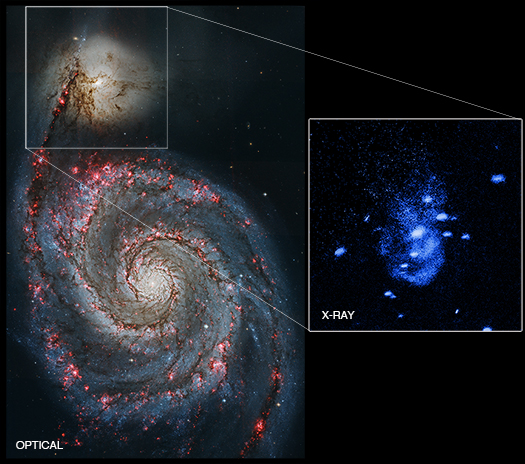
Astronomers have used NASA's Chandra X-ray Observatory to discover one of the nearest supermassive black holes to Earth that is currently undergoing powerful outbursts, as described in our latest press release. This galactic burping was found in the Messier 51 galaxy, which is located about 26 million light years from Earth and, contains a large spiral galaxy NGC 5194 (also known by its nickname of the "Whirlpool"), merging with a smaller companion galaxy NGC 5195.
Submitted by chandra on Wed, 2015-02-25 09:34
 Mar Mezcua
Mar MezcuaWe are pleased to welcome Mar Mezcua as a guest blogger today. She led the study that is the subject of our latest press release, about an intermediate mass black hole. Mar is from Balaguer (Lleida, Spain) and studied Physics in the University Autonomous of Barcelona and in the University of La Laguna, where she also specialized in Astrophysics. She completed her PhD at the Max-Planck-Institut fuer Radioastronomie (Bonn, Germany) in 2011 and then moved to the Instituto de Astrofisica de Canarias (Canary Islands, Spain) as a postdoctoral researcher. She is currently a postdoctoral researcher at the Harvard-Smithsonian Center for Astrophysics.
I found my calling when I was 13 years old and serendipitously watched a documentary on TV about galaxies and supermassive black holes. I wanted to become an astrophysicist and study these exciting objects!
Supermassive black holes reside at the center of galaxies and are more than a million times more massive than the Sun. As their name implies, they are black and thus cannot be observed directly. Hence, to detect black holes we have to observe the matter that surrounds and feeds them, this is, the material that the black hole “accretes.” In supermassive black holes, this accreting material heats up high enough to emit X-rays so that we can detect it with X-ray satellites like NASA’s Chandra X-ray Observatory. Some supermassive black holes also eject outflows of plasma or jets, which emit mainly at radio wavelengths.
Submitted by chandra on Wed, 2015-02-25 09:30
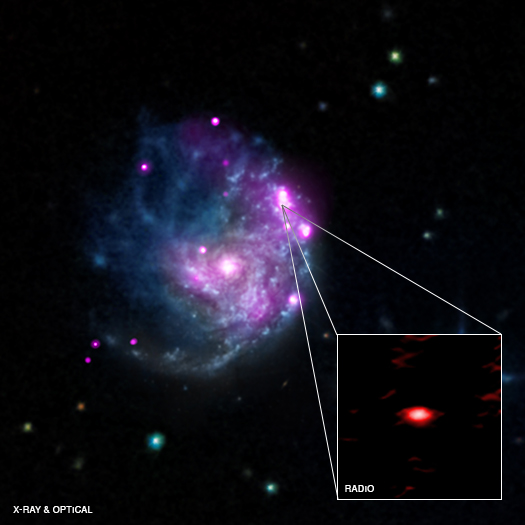
A newly discovered object in the galaxy NGC 2276 may prove to be an important black hole that helps fill in the evolutionary story of these exotic objects, as described in our latest press release. The main image in this graphic contains a composite image of NGC 2766 that includes X-rays from NASA's Chandra X-ray Observatory (pink) combined with optical data from the Hubble Space Telescope and the Digitized Sky Survey (red, green and blue). The inset is a zoom into the interesting source that lies in one of the galaxy's spiral arms. This object, called NGC 2276-3c, is seen in radio waves (red) in observations from the European Very Long Baseline Interferometry Network, or EVN.
Submitted by chandra on Thu, 2014-12-11 13:48
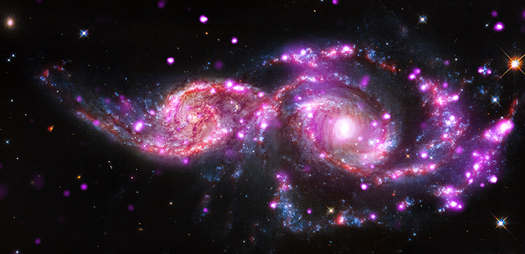
At this time of year, there are lots of gatherings often decorated with festive lights. When galaxies get together, there is the chance of a spectacular light show as is the case with NGC 2207 and IC 2163
Located about 130 million light years from Earth, in the constellation of Canis Major, this pair of spiral galaxies has been caught in a grazing encounter. NGC 2207 and IC 2163 have hosted three supernova explosions in the past 15 years and have produced one of the most bountiful collections of super bright X-ray lights known. These special objects - known as "ultraluminous X-ray sources" (ULXs) - have been found using data from NASA's Chandra X-ray Observatory.
Submitted by chandra on Tue, 2014-10-21 08:10
Today we released six new images from Chandra’s vast data archive. Each one of these astronomical images combines X-rays from Chandra with data from telescopes that detect different types of light such as infrared, radio, and visible light.
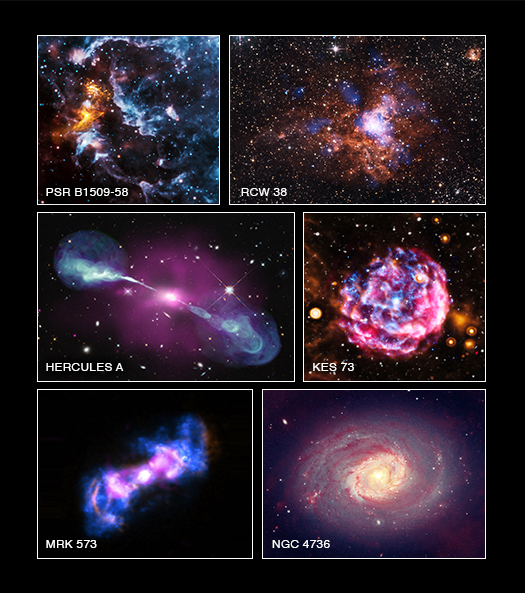
Submitted by chandra on Tue, 2014-10-21 08:05

Every year, NASA's Chandra X-ray Observatory looks at hundreds of objects throughout space to help expand our understanding of the Universe. Ultimately, these data are stored in the Chandra Data Archive, an electronic repository that provides access to these unique X-ray findings for anyone who would like to explore them. With the passing of Chandra's 15th anniversary in operation on August 26, 1999, the archive continues to grow as each successive year adds to the enormous and invaluable dataset.
Submitted by chandra on Wed, 2014-10-08 12:32
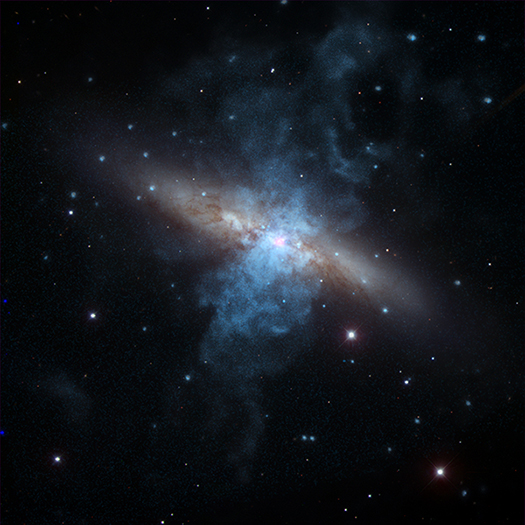
An Ultraluminous X-ray Source (ULX) that astronomers had thought was a black hole is really the brightest pulsar ever recorded. ULXs are objects that produce more X-rays than most "normal" X-ray binary systems, in which a star is orbiting a neutron star or a stellar-mass black hole. Black holes in these X-ray binary systems generally weigh about five to thirty times the mass of the sun.
Submitted by chandra on Thu, 2014-08-14 09:18
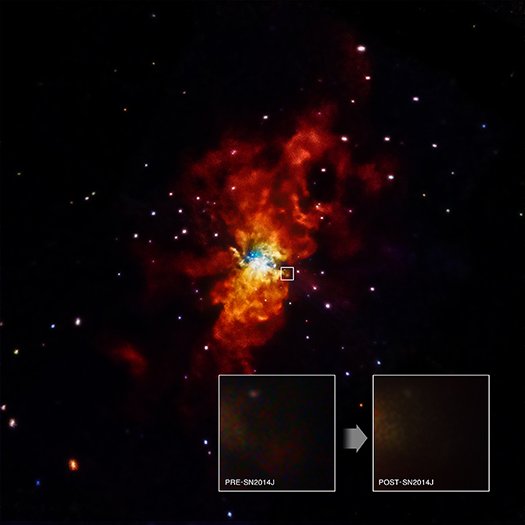
New data from NASA's Chandra X-ray Observatory has provided stringent constraints on the environment around one of the closest supernovas discovered in decades. The Chandra results provide insight into possible cause of the explosion, as described in our press release.
Submitted by chandra on Wed, 2014-07-02 15:09
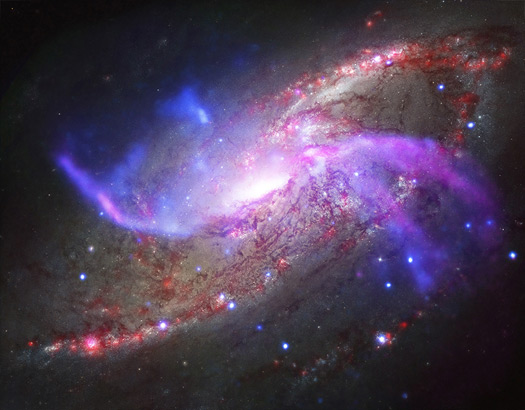
A galaxy about 23 million light years away is the site of impressive, ongoing, fireworks. Rather than paper, powder, and fire, this galactic light show involves a giant black hole, shock waves, and vast reservoirs of gas.
Submitted by chandra on Tue, 2014-06-03 10:30
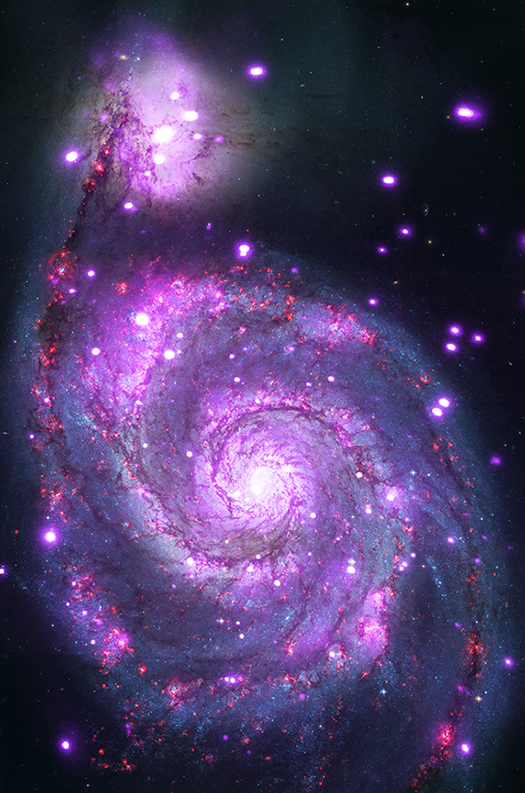
Nearly a million seconds of observing time with NASA's Chandra X-ray Observatory has revealed a spiral galaxy similar to the Milky Way glittering with hundreds of X-ray points of light.
The galaxy is officially named Messier 51 (M51) or NGC 5194, but often goes by its nickname of the "Whirlpool Galaxy." Like the Milky Way, the Whirlpool is a spiral galaxy with spectacular arms of stars and dust. M51 is located about 30 million light years from Earth, and its face-on orientation to Earth gives us a perspective that we can never get of our own spiral galactic home.
Pages